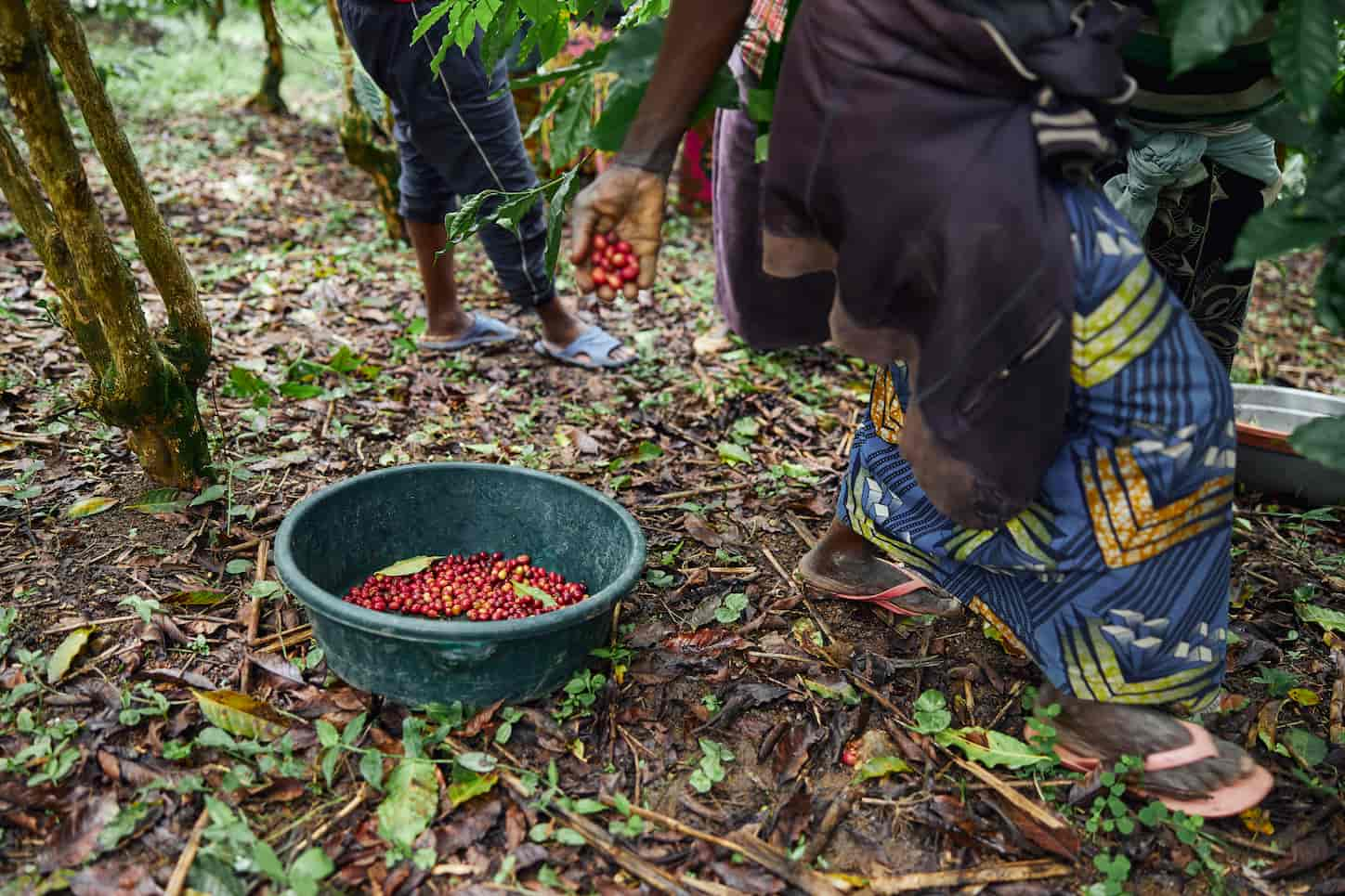Beans are healthy, nutritious foods that come in many different varieties. Growing beans and other things in the garden one year, one of my younger children commented on how tall some plants get. Then, they asked if beans grow on trees.
Beans like coffee and carob beans grow on trees or plants, while most garden types of beans do not grow on trees. Most kinds of bean plants are either bush plants or pole plants. Bush plants grow on their own, while pole beans require a pole or trellis.
Beans need full and direct sunlight, and well-drained soil and the soil should have a pH between 6 and 7.
If you are interested in planting your own beans and want to learn more, be sure to keep reading. In this article, I will explain how beans grow in more detail.

Where Do Beans Grow?
Common beans (Phaseolus vulgaris) grow in well-drained soil and require six to eight hours of sunlight every day. Beans grow and are harvested in many countries around the world, including many parts of the United States, Brazil, China, and India.
Beans can grow pretty much anywhere. They really are amazing plants.
If you’re wanting to grow one of the “regular” kinds of beans, they’re the variety that will either be labeled as a bush or pole bean.
What Types of Beans Grow on Trees?
Coffee beans and carob beans are examples of beans that can grow on trees. Coffee beans mostly grow on small evergreen trees or coffee plants, and carob beans also grow on evergreen trees, known as carob trees.
Now, I want to explain how carob and coffee beans grow in a bit more detail. Neither coffee nor carob trees (or their beans) grow well in my yard, so this was cool to research and learn about.
Coffee bean facts
Coffee beans begin as seeds and grow into plants or trees. It takes three to four years for a coffee tree to fruit, so it requires some patience.
They grow best in temperatures consistently between 64 to 70 degrees Fahrenheit, so it is possible to grow them in certain parts of the United States, such as California and Hawaii. However, coffee beans are most commonly grown in Brazil, Vietnam, and Colombia.
Once the coffee beans are ripe, they are known as cherries due to their often-red color. The cherries are harvested and dried before being milled.
If you’re wanting to grow your own coffee bean trees, it may be best to first invest in a temperature-controlled greenhouse, depending on where you live.
Got coffee questions? I can’t help you much, but I know the folks at Dial-Up the Coffee and Top Off My Coffee. They both know what they’re talking about with regard to coffee, so go check them out. The links open in a new window, so you won’t lose your place here!
When we were researching trees for our yard, we came across the Kentucky Coffeetree. It grows pods that can be used to make a kind of coffee, just not regular coffee. And the Kentucky Coffeetree grows well in large areas across the United States.
So, if you want your own coffee tree, a Kentucky Coffeetree might be the way to go. I understand the coffee tastes different, though. We’re not coffee drinkers, so we ended up going with another tree.

Carob bean facts
Carob beans come from the pods of the carob tree. People often grind the beans, and they have a similar taste to chocolate, so they can be a substitute for cocoa powder.
Carob trees grow mostly within the Mediterranean but are planted in the United States, particularly in California.
These trees do best in warmer climates and are prone to frost damage during cold spells. The ideal weather for these trees to grow is a Mediterranean climate.
Difference Between Bean Types (Bush vs. Vine)
There are two main types of garden beans: bush and vine (pole) beans.
- Bush beans grow into freestanding bushes. Varieties include snap, dry, and green beans.
- Pole or vine beans require a trellis (or a pole) to grow. Varieties include stringless green beans, rattlesnake pole beans, climbing beans, and ornamental beans.
I will explain the difference between them in detail below.
Bush beans
Bush beans are planted in rows and only tend to grow as tall as two feet. As the beans grow, they do not require any outside support from a trellis or stake.
There are three main types of bush beans: snap beans, dry beans, and green beans. Like many other plants, bush beans also require plenty of sunlight and well-drained soil.
In general, bush beans require less work than vine beans because they are easier to plant and grow.
Vine beans
Vine beans tend to grow taller than bush beans, and they require outside support to stay upright. Any stake will work to keep the plant from drooping downwards if it is placed in the correct position.
Vine beans do best in warm temperatures of at least 60 degrees Fahrenheit and in well-drained soil.
Although vine beans require a bit more maintenance and effort, they tend to produce more beans than bush beans.
So, if you want a heavier harvest of beans, pole beans are the way to go.

Do Bean Plants Need Water?
Common beans require one inch of water per week. Therefore, watering is necessary for areas that do not have much rainfall. However, too much water can damage the plant and cause issues such as fungus and slower growth. Although some water is needed, the soil should mostly be well-drained.
When Is the Best Time to Plant Beans?
The best time to plant beans is in spring once the danger of frost has passed. If beans are grown too early, the cold weather and moisture can slow the germination process and even cause the beans to rot and die. Planting them in the newly warm soil gives them the best chance of growth.
Bush beans can be harvested up to 55 days after planting, and vine beans can be harvested up to 65 days after planting. So, growing them in spring means you can have your beans ready for harvest by the summer.
There are some varieties of beans that can be planted outdoors earlier than other plants. We have relatives who plant those in mid to late April.
We tend to stick to our favorite bean varieties and start them indoors. We transplant them in mid-May after the danger of frost has passed.
Can You Plant Beans All Year Round?
If you live in a region with warm weather throughout the year or you have a greenhouse, then you may be able to grow beans all year round.
Most common beans grow best in temperatures between 65 to 85 degrees Fahrenheit. If your region is within these temperatures throughout the year, you can plant your beans whenever you need to!
However, if there are wet periods during the year, it’s best to wait until the weather is drier. If bean plants get too wet, it can slow their growth significantly. It could also rot the plant.

Next Steps: Plant Your Beans
Most garden bean varieties don’t grow on trees, but they do grow easily on bean plants. The main things that you need are seeds, adequate space, and the right weather conditions.
Now that you are more aware of how beans grow, you can enjoy planting your own!
But before you do that, go give this article about another commonly-asked question about another vegetable growing on a tree a read next: Can Carrots Grow on Trees?
Resources
Learning from your own experience is essential, but learning from others is also intelligent. These are the sources used in this article and our research to be more informed as homesteaders.
- “Carob | Plant.” Encyclopedia Britannica, www.britannica.com/plant/carob. Accessed 22 Dec. 2021.
- Dowling, Morton, Curtis, Julia. “Fruits of Warm Climates. Julia F. Morton, Curtis F. Dowling, Jr.” The Quarterly Review of Biology, vol. 64, no. 3, 1989, pp. 65–69. Crossref, hort.purdue.edu/newcrop/morton/carob.html#Climate.
- Vakulenko, Galyna. “Tree Spotlight: Carob Tree.” Canopy, 4 Feb. 2019, canopy.org/blog/tree-spotlight-carob-tree.
